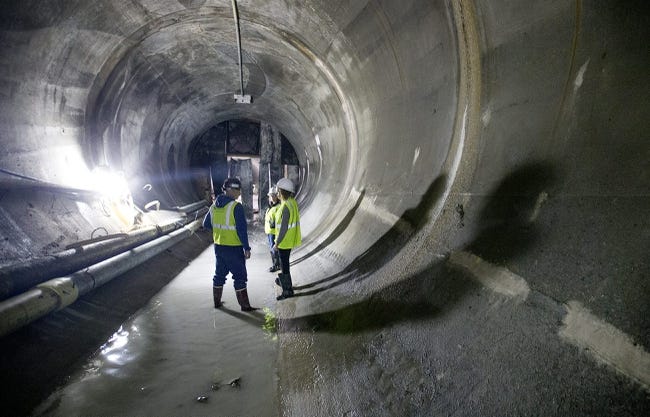The Indianapolis sewer system was originally built as a combined sewer system. Common from the late-1800s to the early-1900s, both stormwater and wastewater flowed into the same pipes, to be carried away from the city and into the . It was not until the mid-1920s that the city’s wastewater was directed through treatment plants before discharging into its rivers and creeks.
Over the years, this system caused increasing environmental problems. Just one-quarter inch of rainfall would lead to the overflow of sewage into the city’s waterways and streets, posing an environmental and public health hazard.
The sewage overflows also became steeped in issues of environmental justice. In 1986, the City of Indianapolis undertook what became known as the Northside Sewer Diversion Project. Residents in , , and other affluent northside areas complained that sewer overflow regularly fouled the White River as it meandered through their neighborhoods.
The city responded by building a four-mile pipeline under the Monon Corridor running from Broad Ripple to . In a presentation to the City-County Council, Mayor stated that the project would provide significant relief to residents all across the north, northwest, and northeast parts of town. The pipeline diverted sewage from northern Indianapolis districts to Fall Creek alongside overwhelmingly poor and African American neighborhoods. During wet weather, these neighborhoods already endured the effects of overflows from points downtown.
In 1999, local nonprofit organizations, including Improving Kids Environment, ; Mapleton-Fall Creek Neighborhood Association, along with the Sierra Club, filed a complaint with the U.S. Environmental Protection Agency (EPA). The complaint explicitly called attention to the fact that sewage overflows disproportionately affected communities of color and lower incomes, while efforts to correct the situation had primarily benefited wealthy areas.
By this time, the presence of sewage in Fall Creek had become so staggering that city officials claimed that it would cost too much to rectify the problem. Mayor filed a lawsuit against the state to prevent implementation of a water discharge permit that would have forced the city to address the sewage overflows. In June 1999, city officials estimated that it would take at least $2 billion to make necessary improvements.
They feared customer reaction to the increases in sewer bills that would result. These improvements included eliminating 130 outlets that mixed waste and rainwater and finding a way to store untreated waste during storms. Goldsmith responded that it made “very little sense to spend $2 billion to $10 billion making White River swimmable all the time.”
Critics chastised city leaders for not doing what was necessary to solve the problem. They pointed to the hundreds of millions of dollars that had been spent on downtown economic development and on subsidization of professional sports and stated that making the investment to improve the health of Indianapolis’ waterways and citizens should instead be prioritized.
Goldsmith did complete some major improvements in the wastewater system, but the EPA investigation that ensued following the 1999 complaint found these remedies to be inadequate. By the early 2000s, on average with rain about 65 days a year the sewer system overflowed, and about 5 to 6 billion gallons of this overflow went into its waterways. To comply with the Clean Water Act, Indianapolis had to come up with a plan to update the aged sewer system and mitigate the wastewater overflow.

In 2006, the city negotiated a consent decree with the EPA and the U.S. Department of Justice, resulting in DigIndy—a plan to curb 99 percent of sewer overflow by 2025. This $2 billion project involved creating a 28-mile network of 18-foot tunnels built 250-feet below Indianapolis. Where the combined sewer system would have been overwhelmed before, the overflow would now be diverted to and stored in the new tunnel system. The overflow would then slowly release into the Southport Advanced Wastewater Treatment Plant.
When took over Indianapolis’ water and sewer utilities in 2011, it also took over responsibility for the DigIndy project. Work officially began on the tunnel system in 2012. By December 2017, the first 10 miles of the new system was complete. A year later, the project hit its halfway point ahead of schedule and under budget.
In addition to the new tunnel system, DigIndy included several related sewer projects. A consolidated collection sewer structure was added to divert sewage from the existing pipes at E. 10th Street/N. Kealing Avenue, , and Market Street/Pine Street to the new DigIndy system. Sewer rehabilitation was completed on many of the city’s pipes through cured-in-place piping lining. Finally, Lift Station No. 104 was replaced, and upgrades were completed at the Belmont and Southport Advanced Wastewater Treatment plants.
DigIndy included projects outside of the sewer realm as well. Working with and the Indianapolis , Citizens planted 10,000 trees for a more natural tactic of reducing overflow. In 2018, the DigIndy Art Project kicked off as a way to bring public awareness to the sewer project. Artists were invited to paint manhole covers that were placed all over the city. Another round of the art project began in 2020 with a mural on a Citizen’s building at Meridian and Westfield streets.
With the increased severity of storms expected due to climate change, experts, by 2020, calculated that the DigIndy tunnels might not be big enough, creating the fear that by the time they are completed they may already be obsolete.

Help improve this entry
Contribute information, offer corrections, suggest images.
You can also recommend new entries related to this topic.